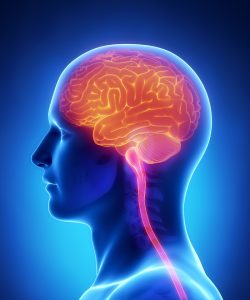The Nitty Gritty. How FSS occurs, in more detail.

If the following section contains terminology and language that is too technical, please click on the overview tab.
While still a novel concept, most cases of Frozen Shoulder Syndrome (FSS) are not caused by adhesions in the shoulder joint. While adhesions are present in patients with FSS, these are typically secondary to the combined effects of chronic inflammation and prolonged reduced mobility typical of the condition as it progresses. Although most cases are multi-factorial, Cranial Nerve XI (CN XI), the Spinal Accessory Nerve appears to be a primary contributor. This particular nerve is the pathway by which the brain activates and controls your trapezius and SCM muscles. These muscles dynamically control the bony elements of the shoulder. In particular, the trapezius muscle controls, positions and stabilizes the shoulder blade ipsilaterally (same side) to allow certain types of motion. Without coordinated action of this muscle on the scapula, motion of the humerus into abduction above 90 degrees and into external rotation is impeded by contact of the humerus and acromion (part of the scapula). This nerve is especially vulnerable to dysfunction in the upper cervical spine because of it’s unique path. Rather than originating in the cranium with the other Cranial Nerves, the rootlets for CNXI emerge from the spinal cord between the 1st and 5th cervical levels and ascend within the spinal canal through the foramen magnum. Once in the calvarium, the spinal root of CN XII joins it’s cranial root and exits the cranium via the jugular foramen with cranial nerves IX and X. It’s this route up through the foramen magnum passing between the brainstem and the skull and all of the other associated structures that makes it vulnerable to compression or tethering/traction.
Patients with frozen shoulder, with this etiology, display a typical contra-lateral flexion/ipsilateral rotation extension head posture coupled with a flattening of the normal cervical lordosis and anterior translation of the occiput on the atlas. These postural changes can negatively impact the function of CN XI in one of two ways. The spinal root of the cranial nerve can either be directly compressed at the level of the foramen magnum as the skull becomes fixed anteriorly, or the straightening of the cervical curve coupled with an ipsilateral lifting of the occiput as it slides laterally and superiorly on the superior articular facet of C1 can generate a tethering of the cervical cord. In the latter mechanism, other cranial nerves may be impacted (typically between CN VIII and XII), and the patient may exhibit other chronic symptoms of the ipsilateral upper extremity (chronic epicondylitis, hypoperfusion, carpal tunnel like symptoms, etc.). These specific postural distortions can be observed with a postural and physical examination and confirmed with radiological examination. As a result, our unique method for treating chronic shoulder dysfunction and Frozen Shoulder, involves a detailed radiological, physical, postural and cranial nerve examination.
If these postural distortions are found, and the patient does not exhibit any contra-indications to treatment, a specific chiropractic adjustment is applied to reduce this biomechanical distortion. When applied correctly to the upper cervical spine, vital neurological connections are restored and many patients experience immediate and dramatic reductions in pain with significant increases in active shoulder and neck range. If the treatment is going to be successful the patient will display significant improvement subjectively or objectively, typically at the first visit. Once this vital mechanism has been restored the patient’s response to conventional physiotherapy is significantly improved and the symptoms/ROM are typically restored fully within 6-8 weeks.
If you have patients that are experiencing chronic shoulder dysfunction, or Frozen Shoulder, we would be happy to co-treat and help your patients achieve a full an timely recovery.
